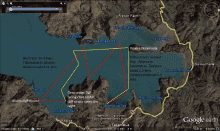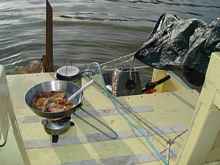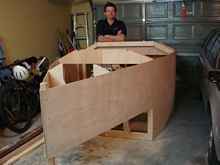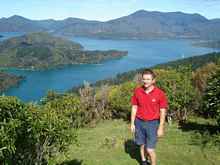
 Custom Search
|
|
| sails |
| plans |
| epoxy |
| rope/line |
| hardware |
| canoe/Kayak |
| sailmaking |
| materials |
| models |
| media |
| tools |
| gear |
 |
 |
| join |
| home |
| indexes |
| classifieds |
| calendar |
| archives |
| about |
| links |
| Join Duckworks Get free newsletter Comment on articles CLICK HERE |
|
|
| Akaroa Trip Report |
by Rob Kellock - Kirwee - New Zealand |
IntroductionHumans have a high tendency with recounts to subtly alter the retelling to exaggerate the actual event or embellish it in some way. In short, errors occur in recounts. The simple game of Chinese whispers shows how radically a message can be changed through communication errors. When the recount involves danger the temptation to alter the story to enhance the reader's opinion of the author is increased further. This is why I have tried to retell this trip report as quickly as possible after it occurred, before the raw emotions of the fear have dissipated to be replaced with the satisfaction of having survived. You may wonder what all the fuss was about having been in worse conditions, but I was in no doubt that I was in a life threatening situation and that is what I'm recounting in the hope that it might help somebody. If not, I do hope it will at least, provide some entertaining reading. Thursday 10/11/11 12.30pmLeft home. Thursday 10/11/11 03.00pmArrive at launching site at Duvachelle. Decide that launching site is too rocky so look for another site. Thursday 10/11/11 04.30pmGet on water at Takamatua in light SW of 5 knots with one reef. Head into main harbour where SW 15 knots is blowing and there are regular white caps. There are no other boats on the harbour. Beat up the harbour with multiple tacks until anchoring briefly under Akaroa light house next to rocky shoreline. Several times during beating to windward, wonder at the sense in going to windward, knowing that the wind direction is forecast to change to strong NE during the night, but figure that my Philsboat will be able to handle beating back even if it takes all day so continue upwind.
Thursday 10/11/11 06.30pmAfter briefly sailing downwind through the moored keelers at Akaroa, the SW dies altogether and I motor into a SW facing cove under steep cliffs that should protect me from the NE during the night. Put out a folding grapnel stern anchor under the cliffs and using the motor, made sure it is secure and then threw out a bow Danforth in deep water. Tugged on that with the stern line and hoped it was secure, then made tea and went to bed after a beautiful sunset and dusk. All light gone at 9.00pm. Thursday 10/11/11 11.00pmHear the roar in the trees on the cliff top as the NE comes through. Occasional gusts come down and move the boat around, but the cliff face means that they come from the SW not NE! Hadn't thought of that. Periodically check boat position during night. It doesn't change, but seem to have much more slack in my anchor lines than I thought and boat moves around a lot. From past experience know that leaving leeboard down stops boat from rocking, but have rudder and OB motor lifted. Don't get much sleep, but not surprised as I never sleep much on a one nighter. A pair of Canada geese honk and fly around all night.
Friday 11/11/11 08.00amAfter a cold breakfast leave cove to beat back up harbour to Takamatua, expecting to get there at 10.00am. Surprised by sail whipped about by NE rotor coming off cliff top and it takes quite a while to leave under sail in the flukey conditions. When clear air is finally reached, again surprised as to how strong it is. Thank goodness, I had taken the precaution of being fully reefed, before leaving. Nevertheless elected to continue into the harbour. Once in the main harbour discovered the NE was blowing between 25 – 30 knots with gusts of 35 – 40 knots. Every wave was a white cap. Fully reefed already I had to let the sail go on each gust. This was seriously scary! Too frightened to attempt to turn back I continued into the middle of the harbour hoping it would be calmer on the other side. I had one near capsize and tried to sail on with thoughts of never seeing my children and wife again. I noticed that the Bear tape protecting the leech of my sail had torn open in a gust. Unfortunately the NE means that the western side of the harbour forms a lee shore and I was unable to identify Tikao Bay, even though I was in fact directly opposite it and it would have provided good shelter. As conditions worsened further, I glanced back and realised that I was now making no progress to windward at all – I was being blown down the harbour! Friday 11/11/11 09.30amIn a brief lull I leaped to the mast and pulled down the sail. I started the outboard motor (I always run it briefly before leaving an anchorage to make sure that it is warm and fill the tank to the brim too) and pointing the boat directly into the wind headed up the harbour hoping to find Tikao Bay, which I mistakenly believed was further up the harbour than it was. I was relieved to see that my 2HP outboard motor was still capable to pushing me into the wind, but soon discovered that a deviation of more than 10 degrees off the wind would result in the boat being pushed downwind. After having to turn downwind and sweep around a full 360 degrees using the downwind speed to get back on course, I felt that the only destination possible was the tip of Onawe Peninsula in the middle of the harbour. As I kept bashing upwind, I worried that I might run out of petrol which could be disastrous and cursed that my life and my boat were totally in the hands of that piece of Japanese machinery running at full throttle behind me. Perhaps 750m from the relative safety of Onawe, I saw a whirlwind coming straight for me, the whipped up spume rising perhaps 30 ft into the air. “If that hits me, what will it do?” I thought, but luckily it dissipated about 50 metres off my bow.
Friday 11/11/11 10.00amAfter reaching Onawe, I put out both my bow and stern anchors, refilled my petrol tank (about half of it had been used to motor 2 kms) and decided to check the weather forecast on my mobile phone. I was going to have to wait in this exposed anchorage for hours! The NE was refracting around the western flank of Onawe with strong gusts of 20+ knots buffeting the boat. The bow was facing the wind and even with the stern anchor in place the boat sailed at anchor badly. However, my holding was good and I wasn't prepared to reorient to a stern anchoring arrangement because I was close to rocks and my sheltered spot was only 100 ft long. Conditions by now were at their worst out in the harbour with whitecaps everywhere. The best I was able to do was put down the leeboard and rudder leaving the tiller locked. This slowed down the sailing at anchor considerably, resulting in less of an arc, although the boat still heeled at the end of each swing. Friday 11/11/11 11.30amThe Coastguard, or at least, somebody looking official in a launch, comes over from Takamatua to check me out. I have no radio and frankly no way of being rescued. I'm so close to the rocky shore it would be dangerous for the launch to approach. The only way for me to get out of this situation would be to leave the boat and swim to shore which was less than 20 ft away. Not a lot of point doing that, so I waved, he waved back and returned to Akaroa. The next few hours were awful. I read until I felt sick, then listened to the radio for some human company (this is the guy who hates the inane babble of DJ's normally), talked to my wife on my cell phone several times, telling her not to do anything and that I would just have to wait for the weather to change. By now, I knew that my anchoring spot while uncomfortable was secure and I would be safe until the conditions changed. I checked my anchor lines a couple of times to make sure they weren't chafing. The stern line was chafing very slightly, so I let out a little more scope.
Friday 11/11/11 02:30pmA Hectors dolphin surfaces right next to the boat. That was cool. Friday 11/11/11 03:30pmThe NE appears to have dropped to 18 knots. I decide to go. I motor straight across the harbour into the shelter of Takamatua Bay. A bit of spray comes into the boat, but the passage is not frightening at all. In Takamatua Bay, I pull the boat out and as I do so the NE picks up again. I count my blessings. Friday 11/11/11 05:30pmOn the drive home the NE is so strong I am concerned that the boat trailer might flip. Opposite Gebbies Pass a strong gust moves the boat sideways on the trailer. Friday 11/11/11 07:06pmArrive home. Conclusion
Philsboat CapabilityWas my Philsboat really up to this? From a construction viewpoint, I think, yes. The boat itself is quite rugged with its low seats reinforcing the ½ inch plywood bottom. The only aspect of it's construction that concerns me is the mast foot. When building a mast foot make sure that the base of the mast jams in the foot and doesn't rest directly on the hull bottom, otherwise when pounding to weather under outboard power you could drive the mast base right through the hull. At the end of this trip the mast was jammed in it's foot so tightly, I had trouble extracting it.
Likewise the leeboard, it's guards and the rudder and tiller arrangement are also quite strong and handled the conditions without problem. |
 |




